Rig Veda Mandal 9
 Minutes to read.
Minutes to read.
Rig Veda Mandal 9
Relevant mantras from Rig Veda Mandal 9 with their actual transation and explanations by Sant Rampal Ji Maharaj. The following ved verses are explained.
- Rig Veda Mandal 9 Sukt 86 Mantra 26 (Kavir atyo - varniye purusho ko milta hai)
- Rig Veda Mandal 9 Sukt 86 Mantra 27 (Dyulok ke teesre prishth pe virajman)
- Rig Veda Mandal 9 Sukt 82 Mantra 1 (raja ke samaan darshaniye.... vidyut..)
- Rig Veda Mandal 9 Sukt 82 Mantra 2 (Kavir Vedhasya)
- Rig Veda Mandal 9 Sukt 96 Mantra 16 (Guham Charu Naam)
- Rig Veda Mandal 9 Sukt 96 Mantra 17 (Shishum jgyanam.. Kavir girbhi Kavyana Kabir)
- Rig Veda Mandal 9 Sukt 96 Mantra 18 (Rishimana.. Kavinaam padvi. tritiyam dham.. virajmanu rajti stupa)
- Rig Veda Mandal 9 Sukt 96 Mantra 19 (turiyam dham)
- Rig Veda Mandal 9 Sukt 96 Mantra 20 (jis prakar sangh ko senapati prapt ...)
- Rig Veda Mandal 9 Sukt 1 Mantra 9 (Abhi Adhanya..)
- Rig Veda Mandal 9 Sukt 95 Mantra 2 (guhani nama avikrishnoti)
- Rigveda Mandal 9, Sukt 94, Mantra 1 (Kaviyan Vrajm)
- Rigveda Mandal 9, Sukt 20, Mantra 1 (Kavir Dev vityaye)
- Rigveda Mandal 9, Sukt 54, Mantra 3 (Bhuvnopari tishtathi)
Rig Veda Mandal 9 Sukt 86 Mantra 26-27

Analysis of Rig Veda Mandal 9 Sukt 86 Mantra 26:
This photocopy is of Rig Veda Mandal 9 Sukt 86 Mantra 26, translated by the scholars of Arya Samaj and disciples of Maharishi Dayanand.
It clearly states that for those who perform Yajnas, i.e., devotees engaged in religious rituals, the Supreme God makes all paths easy—removing suffering from the journey of life and making it smooth. He destroys their obstacles and troubles. He purifies devotees, making them sinless and free from vices.
As stated in the next Mantra 27: "The Supreme God is seated on the third level of Dyuloka, which means Satlok. The radiance of His body is immense." For example, the light from a single hair on His body surpasses the combined brightness of a billion suns and moons. If that Supreme God were to appear on Earth in that luminous form, human eyes would be unable to behold Him—just as an owl cannot see anything in the daylight due to the sun's brightness. The same would happen to humans.
Thus, the Supreme God moderates His divine radiance and descends from His eternal abode. He moves swiftly like lightning, performing divine pastimes (plays) and appearing before the righteous souls. It is also explicitly mentioned that He is Kavih, meaning Kavirdev. We call Him Kabir Saheb.

Analysis of Rig Veda Mandal 9 Sukt 86 Mantra 27:
This photocopy is of Rig Veda Mandal 9 Sukt 86 Mantra 27, which clearly states: "The Supreme God resides on the third level of Dyuloka, which means the eternal realm."
Satlok, the eternal place, consists of three parts:
-
The Outer Region: This includes forests, mountains, waterfalls, gardens, and orchards. (Comparable to Delhi, the capital of India, which is divided into three sections: outer Delhi, consisting of villages, fields, and canals; the second part, which is the marketplace; and the third, where Parliament and government offices are located.)
-
The Residential Area: This is where liberated Hans atmas (pure souls) reside with their families. (On Earth, a devotee is called a Bhakt, but in Satlok, they are called Hans atmas.)
-
The Supreme Region: This is where the throne of the Supreme God is situated. Only male souls reside near Him; there are no male-female pairs. If a being desires a family, they can create a child simply through divine words (speech).
Thus, the eternal realm (Satlok) is divided into three parts by the Supreme God. In Satlok, no one experiences old age or death. That is why Bhagavad Gita Chapter 7 Verse 29 states that those who seek liberation from old age and death ultimately come to know the Supreme God, Param Akshar Brahm.
Satlok is the eternal abode of Satpurush (the Eternal God), where there is no old age or death. Children grow into youth and remain forever youthful.
Rig Veda Mandal 9 Sukt 82 Mantra 1-2
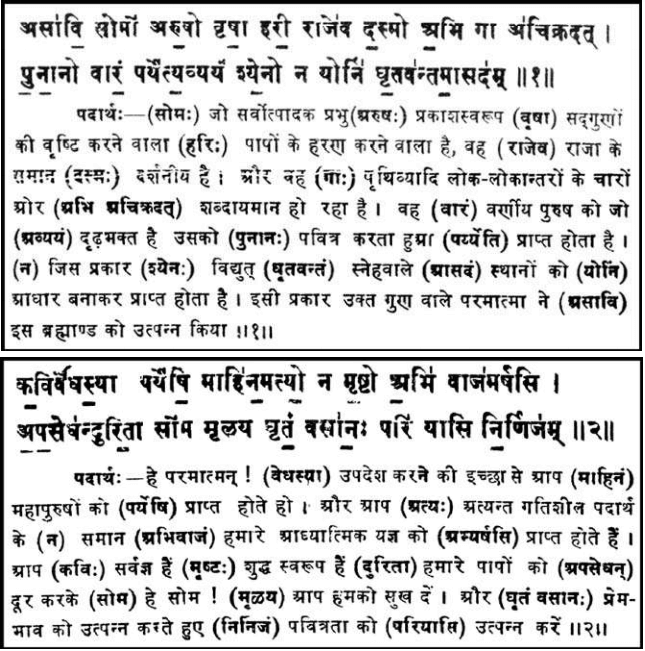
Analysis:
The photocopy above contains Rig Veda Mandal 9 Sukt 82 Mantra 1-2, translated under the guidance of Maharishi Dayanand by his disciples and published by the Sarvadeshik Arya Pratinidhi Sabha, Delhi.
Rig Veda Mandal 9 Sukt 82 Mantra 1 Explanation:
It is clearly stated that: "The Supreme God, who is the creator of all, possesses a radiant body. He destroys sins and showers boundless happiness upon beings. He is seated on His throne in the higher realm of Satlok, appearing like a king."
This is also confirmed in Sukshm Ved:
"Arsh Kursh par safed gumat hai, jahan Parameshwar ka dera.
Shwet chhatr sir mukut viraje, dekhata na us chehre nu."
Similar evidence is found in the Bible and the Quran Sharif, stating that God created the universe in six days and rested on the seventh, taking His seat on the divine throne in the sky. (Bible - Genesis 2:26-30, Quran Sharif - Surah Al-Furqan 25:52-59).
The Supreme God descends from His eternal realm and imparts divine knowledge through His words. He is attained by highly revered and virtuous souls, such as:
- Sant Dharamdas Ji (from Bandhavgarh, Madhya Pradesh)
- Sant Malook Das Ji
- Sant Dadu Das Ji (met in Amer, Rajasthan)
- Sant Nanak Dev Ji
- Sant Garib Das Ji (from village Chhudani, Jhajjar district, Haryana)
- Sant Ghisa Das Ji (from village Khekra, Baghpat district, Uttar Pradesh)
The Supreme God is drawn toward pure and steadfast devotees. He is particularly attracted to those who have unwavering faith in Him. An example is given:
"Just as lightning tends to strike objects that have a natural affinity for it, like brass utensils (which were carefully kept indoors during storms due to their tendency to attract lightning), similarly, God is drawn toward His dear devotees and grants them divine encounters."
Rig Veda Mandal 9 Sukt 82 Mantra 2 Explanation:
This mantra further clarifies that the Supreme God personally meets great saints to impart spiritual knowledge. The purpose of this divine meeting is to grant initiation (Diksha) and teach true spiritual wisdom (Tatvgyan).
Thus, the Satguru of these enlightened beings is none other than the Supreme God Himself.
It is also stated that God moves with lightning-like speed and personally attends religious rituals and spiritual gatherings.
Previously, you read that Sant Dharamdas Ji was told by God:
"I always visit places where true religious ceremonies are conducted. In My absence, Kaal (Satan) tries to create disturbances, leading seekers astray from the Supreme God. But in My presence, he cannot cause any trouble."
This is why Bhagavad Gita Chapter 3 Verse 15 states:
"The immortal Supreme God, who even created Brahm (Kaal), is always present in sacred rituals and should be worshipped as the sole deity through prayers and hymns."
The Rig Veda Mandal 9 Sukt 82 Mantra 2 explicitly confirms:
- (Kavirvedhasya) The Supreme God is Kavirdev (Kabir Saheb), who descends to impart spiritual knowledge to all beings.
- He is the purest and most sacred divine being, who liberates souls from sins.
- The eternal, immortal Supreme God is prayed to for ultimate bliss.
- The mantra further states:
- (Dyutam vasanah nirnijam pariyasi) → "O Supreme Father! You are our Divine Parent. Please manifest Your beautiful divine form before us, just as You have always appeared to Your dear souls throughout history."
Thus, the Rig Veda validates that the Supreme God is Kavirdev (Kabir Saheb), who comes to guide humanity and grant salvation to His true devotees.
Rig Veda Mandal 9 Sukt 96 Mantra 16 to 20
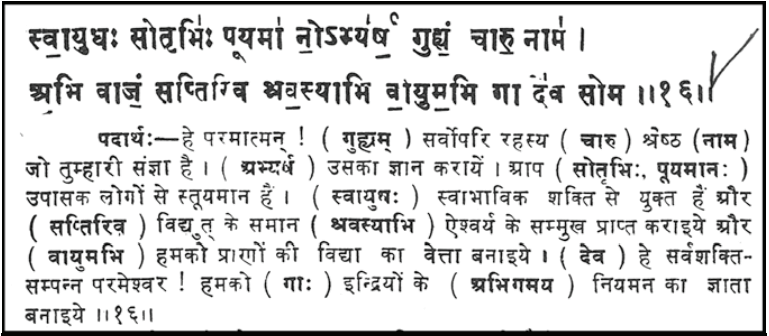
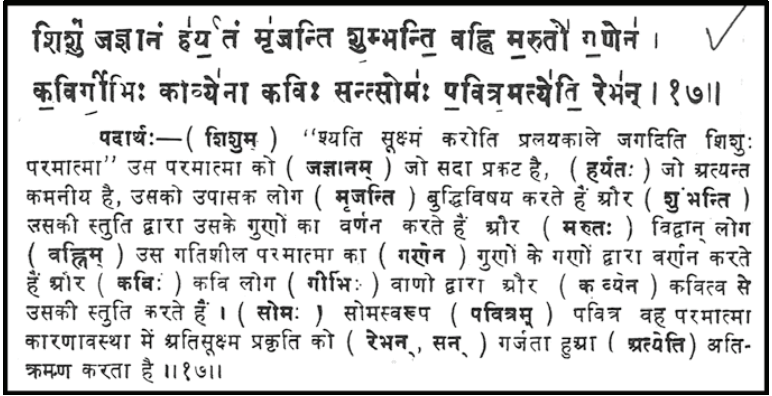
Rig Veda Mandal 9 Sukt 96 Mantra 16 Explanation: (Guham Charu Naam)
Rig Veda Mandal 9 Sukt 96 Mantra 16 states: "O Supreme God! Please reveal the knowledge of Your most superior and secret name."
This divine name is revealed in Mantra 17, which states that He is "Kavih" (Kavirdev).
Rig Veda Mandal 9 Sukt 96 Mantra 17 Explanation (Hindi Interpretation):
शिशुम् जज्ञानम् हर्यतम् मृजन्ति शुम्भन्ति वह्निम् मरुतः गणेन
कविः गीःऽभिः काव्येन कविः सन्त् सोमः पवित्रम् अति एति रेभन् ॥
- (Shishum Jagyanam Haryantam) – The Supreme God deliberately appears in an infant form with the intention of imparting true spiritual knowledge.
- Upon hearing His divine wisdom (Maruto Ganena) – a vast group of devotees becomes His followers.
- (Mrjanti Sumyanti Vahin) – Intellectuals comprehend this supreme knowledge and praise Him through devotion based on spiritual wisdom. This devotion (Vahin) quickly yields results and benefits the seekers.
- (Kavyena Kavir Girbhih Pavitram Atirebhan) – The Supreme God delivers His knowledge in poetic form, using dohas, shabads, proverbs, and chaupais like a poet. His words are known as "Kabir Vani", which He speaks in a loud and resounding voice to convey pure and sacred knowledge.
- (Kavih Santah Som) – This Kavirdev, who acts as a poet, descends in the form of a Saint. He is Som (the Eternal Supreme God).
Key Note: In the original Sanskrit text of this mantra, the word "Kavih" (Kavirdev) appears twice. However, Arya Samaj translators have ignored one instance of "Kavih" in their interpretation.
Rig Veda Mandal 9 Sukt 96 Mantra 18 Explanation:
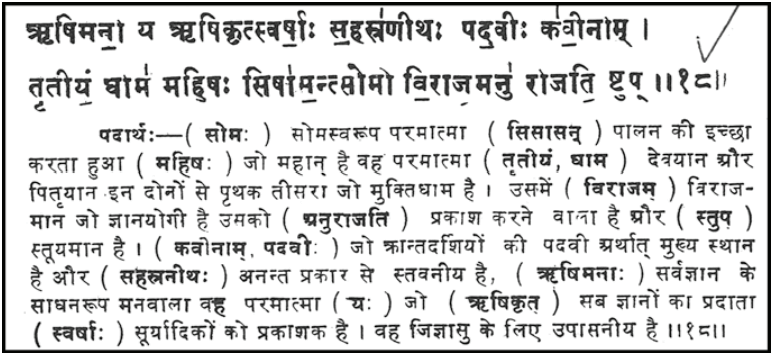
The photocopy of Rig Veda Mandal 9 Sukt 96 Mantra 18, translated by disciples of Maharishi Dayanand and published by Sarvadeshik Arya Pratinidhi Sabha, Delhi, contains several translation errors. Since we understand Sanskrit, we will analyze and provide an accurate interpretation:
ऋषिमनाः यः ऋषिकृत् स्वःऽसाः सहस्रऽनीथः पदवीः कवीनाम्
तृतीयम् धाम महिषः सिसासन् सोमः विराजम् अनु राजति स्तुप् ॥
In Mantra 17, it is said that the Supreme Being manifests as a sage or saint and speaks the immortal words from His lotus-like mouth. Understanding that knowledge, a multitude of followers is formed.
- (Yah) – The divine speech pertaining to the true knowledge (tatvgyan) that Supreme God speaks.
- (Rishikrit) – Composed by the Supreme God manifest in the form of a Rishi.
- (Sahasraniyah) – Thousands of divine speeches (Kabir Vani) that He speaks.
- (Rishimana) – for devotees who have the mindset of sages (rishi-like devotees).
- Savarsha - is calming.
- (Kavinaam Padavih) – Since God utters the speeches in poetic form, He also attains the title of a poet among the greatest poets.
- (Som Sishasan) – The Eternal Supreme God wishes to sustain and nurture all souls.
- (Mahisah) – Initially, this Supreme God resides in the higher celestial realms (great divine worlds).
- (Trtiyam Dham Anurajati) – He is seated in the third realm of Satlok (the eternal divine abode).
- (Stupa Virajam) – In that realm, He sits in a grand luminous dome, possessing a radiant divine form.
This truth is also confirmed in Rig Veda Mandal 9 Sukt 54 Mantra 3, which states that the Supreme God resides in the highest realms above all universes.
Rig Veda Mandal 9 Sukt 96 Mantra 19

Analysis of Rig Veda Mandal 9 Sukt 96 Mantra 19:
The scholars of Arya Samaj have translated Rig Veda Mandal 9 Sukt 96 Mantra 19, but their translation contains several errors. Due to the vastness of the text, we will focus only on the essential details.
This mantra describes the fourth divine realm, which is also detailed in the creation of the universe.
The Supreme God has created four eternal, indestructible realms above this material world:
- Anami Lok – The highest and most supreme realm.
- Agam Lok
- Alakh Lok
- Satlok
We currently reside in the earthly realm (Prithvi Lok). Counting upward from here, we get:
- 1st: Satlok
- 2nd: Alakh Lok
- 3rd: Agam Lok
- 4th: Anami Lok
It is in this fourth divine realm (Anami Lok) that the Supreme God originally created all universes and celestial worlds. The remaining creation was completed while seated in Satlok.
The Arya Samaj translators have mentioned the Turiya (Fourth) Supreme God, which actually refers to the Supreme God seated in the fourth divine realm (Anami Lok).
The essence of Mantra 19 is:
- A Tatvadarshi Sant (True Spiritual Saint) provides a distinct and clear description (Vivakti) of this fourth realm and the Supreme God of the fourth realm.
- To understand the complete Creation of the Universe, refer to page 208 of this book.
- Saint Rampal Ji is identified as that Tatvadarshi Sant who possesses complete spiritual knowledge (Tatvagyan).
Analysis of Rig Veda Mandal 9 Sukt 96 Mantra 20:
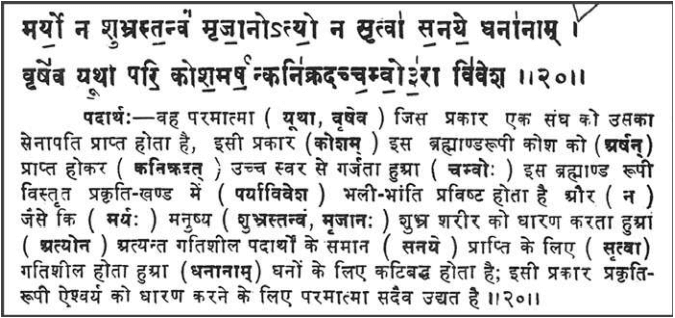
Now, let us understand the true meaning of Rig Veda Mandal 9 Sukt 96 Mantra 20:
This mantra was translated by Maharishi Dayanand's disciples, but their interpretation is influenced by the belief that God is formless. Since Maharishi Dayanand firmly advocated the concept of a formless God, the translators deliberately altered the original meaning of the mantra to align with that belief.
The original Sanskrit text states:
मर्य न शुभ्रः तन्वा मृजानः अत्यः न सृत्वा सनये धनानाम्।
वृर्षेव यूथा परि कोशम अर्षन् कनिक्रदत् चम्वोः आविवेश।।
Correct Translation & Meaning:
- Just as a human (Maryah Na) wears a beautiful garment, the Supreme God (Shubhra Tanu) assumes a radiant, divine human-like form.
- (Mrijanah) – He manifests in a bodily form and descends swiftly (Atyah).
- (Sanaye Dhananam) – He comes to bless and grant knowledge to virtuous souls who possess the wealth of devotion (Bhakti Dhan).
- (Vrish Eva Yutha) – Just as a group attains a leader (Senapati), when Supreme God descends as a Saint or Rishi, a large number of disciples follow Him, and He guides them as their Guru.
- (Pari Kosham Arshan) – The Supreme God first enters the highest celestial realm (First Brahmand).
- (Kanikradat) – He loudly proclaims the eternal truth (Tatvagyan).
- (Chamvoh Avivasha) – From there, He descends to Earth to impart true spiritual knowledge.
Conclusion of Rig Veda Mandal 9 Sukt 96 Mantra 20:
As described in earlier Rig Veda verses, the Supreme God resides in the highest realm and then descends to Earth in a human-like form.
This mantra confirms:
- The Supreme God takes on a divine, visible form just as a human wears clothes.
- He comes to Earth to enlighten righteous devotees.
- He gathers a vast following, acting as their Guru.
- Before arriving on Earth, He first appears in the highest celestial realms.
- He loudly proclaims the true spiritual knowledge.
Final Analysis:
These are photocopies of Rig Veda Mandal 9 Sukt 96 Mantras 16-20, translated by the followers of Maharishi Dayanand Saraswati under his guidance. While some portions of their translation are somewhat correct, many errors exist due to their preconceived notion of a formless God.
I have corrected these errors and provided a refined and accurate explanation based on the original Sanskrit meanings. Now, I will further rectify the remaining mistakes and present the most authentic interpretation of these mantras.
Correct explanation of the above Ved Mantras 9:96:16 - 20
Rig Veda Mandal 9 Sukt 96 Mantra 16
सु आयुधः । सोतृ भिः । पूयमानः । अभि । अर्ष । गुह्यम् । चारु । नाम । अभि । वाजम् । सप्तिः इव । श्रवस्या । अभि । वायुम् । अभि । गाः । देव । सोम ॥
This mantra states:
"O Supreme God! Your hidden, real (Charu) supreme (Naam) name—please reveal its knowledge to us."
Example for understanding:
Just as the Prime Minister of India is addressed by his title, but his actual name is something else (e.g., Jawaharlal Nehru was the first Prime Minister, but "Jawaharlal" was his actual name), similarly, the Supreme God has a hidden, true name that He alone can reveal.
Meaning of the mantra:
- (Sotrumih) – The real name of God is meant for worship and devotion.
- (Sva Ayudhah) – This name is like a self-operating divine weapon, which destroys the filth of ignorance and sins.
- (Puyamanah) – By this name, sins are eliminated and one attains purification.
- (Dev Soma) – O Immortal Supreme God,
- (Vasum Abhi) – By chanting this mantra through breath (inhale & exhale) using the nose and other sensory organs,
- (Saptiriva) – Just like the speed of lightning,
- (Abhivajam) – It fills the devotee with the wealth of true devotion
- (Shravasyami) – And grants prosperity and salvation.
Correction in translation:
Earlier translations contained several errors. For instance:
- The original Sanskrit text contains the word "Abhivajam," which was completely omitted in some translations.
- Instead, the meaning of a different word "Abhigamay" (which is not even present in the original text) was falsely inserted.
- I have corrected these errors and provided the authentic meaning of the mantra.
Rig Veda Mandal 9 Sukt 96 Mantra 17
Key Message of the Mantra:
This mantra supports the idea that the Supreme God Himself descends from His eternal realm to Earth with a specific purpose.
- As per Rig Veda Mandal 9 Sukt 86 & 82, God resides in His eternal realm (third divine place of Dyulok).
- He descends to Earth deliberately for a special purpose.
Three ways in which Supreme God governs all universes:
- From Satlok (Eternal Abode) – He sits on His throne and controls all universes.
- Appearing in Saintly Form – He lowers His divine brilliance and meets virtuous souls as a saint.
- Manifesting as an Infant on a Lotus Flower –
- In every age (Yuga), He appears as an infant on a blooming lotus in a water body.
- A childless couple takes Him home and raises Him.
- From childhood itself, He preaches true spiritual knowledge (Tatvagyan) in the form of verses, couplets, and poetry.
Example:
In 1398 CE (Vikram Samvat 1455), the Supreme God descended from His divine realm and appeared in a lotus flower in the Lahartara pond near Kashi (Varanasi, India).
- A weaver couple, Neeru-Neema, took the infant home.
- As He grew, He preached true spiritual wisdom through Kabir Vani.
- The evidence of this is found in Rig Veda Mandal 9 Sukt 1 Mantra 9.
Rig Veda Mandal 9 Sukt 1 Mantra 9
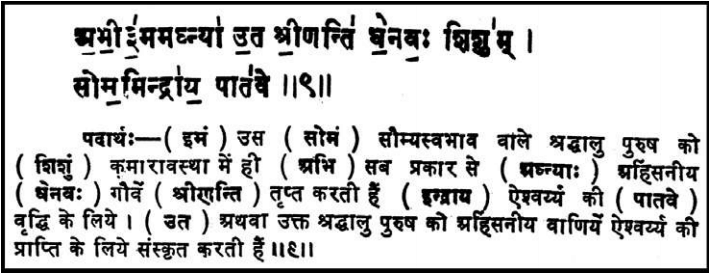
This mantra describes how the Supreme God is raised as an infant on Earth.
- The original Sanskrit text states that when Supreme God appears in an infant form, His nurturing takes place through a special divine arrangement.
- The mantra mentions (Abhi Adhnya Dhenuvah) – which means "nurtured by young, virgin cows."
Confirmation from Kabir Sagar (Chapter: Gyan Prakash)
- When Neeru-Neema took baby Kabir home,
- The child neither ate food nor drank milk.
- Upon Swami Ramanand Ji's advice, Neeru brought a virgin cow (a heifer).
- Miraculously, the cow produced milk, which was used to nourish the divine infant.
Correction in translation:
- The original Sanskrit text contains (Abhi Adhnya Dhenuvah), which refers to virgin cows.
- However, Arya Samaj translators wrongly interpreted (Abhi Adhnya) as “Ahimsaniya” (Non-violent), which is incorrect.
- In Haryana dialect, an unpregnant cow is called "Adhni", and in plural form, it is "Adhnya".
- "Abhi Adhnya" means completely unpregnant, i.e., virgin cows (heifers).
Now, I will provide an accurate translation of Rigveda Mandal 9, Sukt 96, Mantra 17:
(शिशुम् जज्ञानम् हर्यन्तम्) The Supreme God purposefully manifests in an infant form to impart true spiritual knowledge (Tattvagyan). Upon hearing this divine wisdom, (मरूतो गणेन) a vast group of devotees becomes followers of that Supreme God. (मृजन्ति शुम्यन्ति वहिन्) Intellectuals understand this knowledge and, on that basis, praise and worship Him. This devotion (worship) is highly beneficial and quickly fruitful.
The Supreme God conveys His Tattvagyan (काव्येना) through poetry, in the form of couplets, sayings, hymns, and verses, (कविर् गीर्भिः) meaning through Kabir Vani (the divine speech of Kabir Sahib).
(पवित्रम् अतिरेभन्) He loudly proclaims this pure knowledge in a resounding voice. He (कविः), appearing as a poet-saint, (सन्त) manifests in a saintly form and is, in fact, the immortal Supreme God (सोम) Himself.
Special Note:
In the original Sanskrit verse, the word "कविः" (Kavi) appears twice. However, the translators from Arya Samaj have omitted translating one occurrence of "कविः" in their interpretation.
Now, let's analyze Rigveda Mandal 9, Sukt 96, Mantra 18
This has been incorrectly translated earlier. Since we understand Sanskrit, I will provide a correct and clear interpretation.
In Mantra 17, it was mentioned that the Supreme God appears in the form of a saint or sage and delivers His divine nectar-like knowledge (Amrit Vani) through His lotus lips. Many people become His followers after comprehending this wisdom.
- (य) The speech (Vani) that the Supreme God delivers, imparting Tattvagyan.
- (ऋषिकृत्) That speech is delivered by the Supreme God appearing in the form of a sage (Rishi).
- (सहंस्रणीथः) Thousands of such divine speeches—known as Kabir Vani—exist.
- (ऋषिमना) This wisdom is cherished by devotees with a saintly disposition.
- (स्वर्षाः) These divine words bring great joy to those with spiritual understanding.
- (कविनाम पदवीः) Because He conveys His knowledge in poetic forms (couplets, verses, etc.), He becomes renowned as a great poet (Kabir Sahib).
- (सोम) That immortal Supreme God
- (सिषासन्) Desiring the well-being of all,
- (महिषः) Initially resides in the higher divine realms
- (तृतीयम् धाम) in the third realm (Satlok)
- (अनुराजति) with His radiant divine body
- (स्तुप) within a celestial dome
- (विराजम्) and remains seated there, sovereign over all universes.
This aligns with Rigveda Mandal 9, Sukt 54, Mantra 3, which also confirms that the Supreme God resides in the highest realms.
Rigveda Mandal 9, Sukt 96, Mantra 19
The Arya Samaj scholars have also mistranslated this mantra. However, instead of analyzing all their errors, let's focus on the essential knowledge this mantra provides.
This verse describes the fourth realm of existence. A complete explanation of Creation is given in this text (refer to page 208 for more details).
The Supreme God has created four eternal realms above:
- Anami Lok (The highest realm)
- Agam Lok
- Alakh Lok
- Satlok
We currently reside in the Earthly realm (Pṛithvilok). Counting upward, the realms are:
- Satlok
- Alakh Lok
- Agam Lok
- Anami Lok
The Supreme God sits in the fourth realm (Anami Lok), from where He created all universes and realms. However, the remaining creations were completed while He was seated in Satlok.
Arya Samaj translators incorrectly describe the concept of the "Fourth God" (Turiya Parameshwar), but the correct interpretation refers to the Supreme God seated in the fourth eternal realm.
In the original Sanskrit text, Mantra 19 clarifies that the "Tattvadarshi Sant" (the enlightened saint) reveals the knowledge of the fourth realm and the Supreme God who resides there. Readers are encouraged to refer to the Creation section (Page 208) for a deeper understanding.
Conclusion: The author (Sant Rampal Das) is the enlightened saint who possesses the true Tattvagyan (knowledge of reality).
Analysis: Understanding the True Meaning of Rigveda Mandal 9, Sukt 96, Mantra 20
The translation of this mantra has been done by the disciples of Maharishi Dayanand, who believed that God is formless. Because of this preconceived notion, they have distorted the direct meaning of the mantra to align with their ideology.
Let’s examine the original Sanskrit text of Mantra 20:
मर्य न शभ्रः तन्वा मृजानः अत्यः न सृत्वा सनये धनानाम्।
वृर्षेव यूथा परि कोशम अर्षन् कनिक्रदत् चम्वोः आविवेश।।
Correct Translation:
- (मर्यः) Just as a human being wears beautiful garments,
- (शभ्रः तन्वा मृजानः) similarly, the Supreme God takes on a divine, beautiful body
- (अत्यः न सृत्वा) and moves with immense speed.
- (धनानाम् सनये) He comes to grant Himself to wealthy devotees, i.e., pious souls rich in devotion.
- (यूथा वृषेव) Just as a commander appears to lead his troop,
- the Supreme God manifests in the form of a saint or sage, and
- a vast number of followers gather around Him, accepting Him as their Guru.
- (परि कोशम् अर्षन्) The Supreme God first enters the first universe (Brahmand),
- (कनिक्रदत्) loudly proclaiming true spiritual knowledge,
- (चम्वौ आविवेश) and then appears on Earth, revealing the truth through His divine words.
Meaning & Explanation:
In previous mantras, the Vedas clearly state that the Supreme God resides in the upper realms and descends to Earth. This mantra reinforces the same fact.
- The Supreme God takes on a physical form to come to Earth, just as humans wear clothes.
- He appears among righteous devotees (pious souls) and imparts Tattvagyan (true knowledge).
- He manifests as a saint or sage and gains many followers.
- He first enters the first universe (Brahmand) and then arrives on Earth, spreading divine wisdom.
This contradicts the belief of Arya Samaj scholars who claim that God is formless. The Vedas themselves state that God takes a form and comes to Earth to grant true knowledge to devotees.
Thus, Rigveda Mandal 9, Sukt 96, Mantra 20 confirms that the Supreme God appears in bodily form and delivers divine wisdom (Tattvagyan) to pious souls.
Rigveda Mandal 9, Sukt 95, Mantra 2
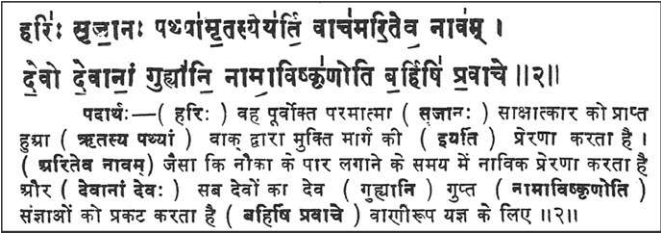
The disciples of Maharishi Dayanand have translated this mantra quite accurately.
Meaning & Explanation:
This mantra speaks about the Supreme God previously mentioned in earlier verses.
- (सृजानः) That Supreme God takes a bodily form.
- (ऋतस्य पथ्यां) He reveals the true path of devotion, i.e., the correct spiritual knowledge,
- Through His immortal speech (divine words), He inspires souls towards the path of liberation.
- (अरितेव नावम्) Just as a boatman ferries people across a river,
- Similarly, the Supreme God helps seekers cross the ocean of material existence by providing the boat of true devotion.
- (देवानाम् देवः) This means the God of all gods, the Lord of all Lords, the Supreme God.
- (बर्हिषि प्रवाचे) Through His divine speech, He reveals hidden, sacred names.
- (गुह्यानि नामा आविष्कृणोति) This means that He manifests certain secret names necessary for liberation.
Relation to Bhagavad Gita 17:23
- In Bhagavad Gita Chapter 17, Verse 23, it is mentioned:
"Om Tat Sat" - Among these, "Tat" and "Sat" are hidden mantras revealed only by the Supreme God to His true disciple (here, referring to Sant Rampal Das).
- These sacred names lead to complete salvation.
Connection to Sukshm Veda (Subtle Vedas):
The Supreme God Himself states in Sukshm Veda:
"Soham" mantra was introduced in the world by Me, but the 'Saar Shabd' (true essence mantra) was kept hidden."
- This indicates that "Soham" was revealed by God,
- But the most powerful mantra (Saar Shabd) was kept secret,
- And now, it has been revealed to Sant Rampal Das, who imparts it to disciples during initiation.
Relation to Bhagavad Gita & True Salvation
- The Soham mantra is not found in any ancient scriptures (Vedas, Gita, Quran, Purans, or Bible).
-
The Sukshma Veda further states:
"Soham is above, but Sat Sukrit is the ultimate name.
Where all pure souls reside, that realm exists beyond any location." -
This means that while "Soham" was revealed,
- The "Saar Shabd" (supreme mantra for salvation) was kept secret until now.
- This "Saar Shabd" is connected to Bhagavad Gita 17:23, where "Om Tat Sat" is mentioned.
Conclusion:
- The Supreme God incarnates on Earth and reveals hidden mantras for salvation.
- "Soham" was introduced openly, but the most powerful mantra (Saar Shabd) remained secret until it was revealed to Sant Rampal Das.
- The correct pronunciation and knowledge of these mantras lead to complete liberation.
Rigveda Mandal 9, Sukt 94, Mantra 1
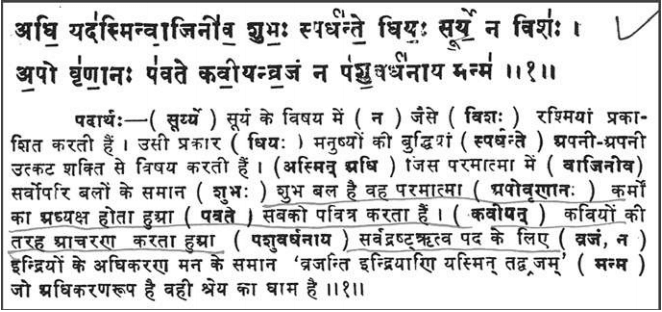
Analysis:
This mantra has been translated by Arya Samaj scholars.
- To avoid unnecessary expansion of the text, their translation is used to support the viewpoint.
- Previous Rigvedic verses state that the Supreme God speaks true spiritual knowledge through His divine speech.
- He conveys this wisdom using proverbs, poetic verses, couplets, hymns, and quatrains,
- Due to His poetic expression, He is recognized as one of the greatest poets.
- His name is Kavirdev (Kabir Saheb).
Meaning of Rigveda Mandal 9, Sukt 94, Mantra 1:
- The Omnipotent Supreme God
- (कवियन् व्रजम् न) "Behaving like a poet,"
- He walks on Earth like a poet-philosopher.
- This confirms that the Supreme God (Kabir Saheb) physically manifests on Earth.
Rigveda Mandal 9, Sukt 20, Mantra 1

Analysis:
This mantra has also been translated by Arya Samaj scholars, but their translation is more incorrect than correct.
The original text of the mantra states:
"प्र कविर्देव वीतये अव्यः वारेभिः अर्षति साह्नान् बिश्वाः अभि स्पृस्धः"
Simplified Meaning:
- (प्र) The one who is distinct from the Vedic knowledge-giver (Brahm)
- (कविर्देव) That Kavirdev (Kabir, the Supreme God)
- (वीतये) Provides spiritual wealth (knowledge) to seekers
- (वारेभिः) Bestows knowledge upon pure souls
- (अर्षति) Imparts true spiritual wisdom
- (अव्यः) He is indestructible, the protector
- (साह्नान्) Extremely tolerant
- (विश्वाः स्पृधः) He completely silences those who oppose true knowledge,
- By (अभि) completely refuting their false arguments in spiritual debates.
Special Observations:
-
Many words have been ignored in the Arya Samaj translation, such as "प्र" and "वारेभिः",
- Due to this omission, the true meaning of the Vedas is not revealed.
-
From my translation, it is clear that the Supreme God imparts knowledge to virtuous souls (devoted seekers).
- His name is written as "Kavirdev."
- We recognize Him as Kabir, the Supreme God.
Rigveda Mandal 9, Sukt 54, Mantra 3

Analysis:
- The Arya Samaj scholars have translated this mantra.
- Their translation also confirms that the Supreme God (भूवनोपरि) resides above all universes, i.e., He sits in a higher realm.
Literal Translation:
"(अयं) This (सोमः देव) immortal Supreme God (सूर्यः) like the Sun (न) similarly (विश्वानि) purifies everything (पुनानः) by sanctifying (भूवनोपरि) sits above all universes (तिष्ठति) remains established."
Meaning:
- Just as the Sun is above and benefits all with its light and warmth,
- Similarly, this Immortal Supreme God (previously described in the Vedic mantras)
- Dwells above all universes,
- Manages and sustains creation through His divine power.
Counterargument Against Maharishi Dayanand’s View
Dayanand’s Belief: Maharishi Dayanand and Arya Samaj followers believe that God does not reside in any specific place or realm.
Evidence from Satyarth Prakash (Chapter 7, Page 148):
- Someone asked: "Is God omnipresent, or does He reside in a specific place?"
- Maharishi Dayanand replied: "He is omnipresent, because if He were limited to one place, He could not be omniscient, all-controlling, and the creator, sustainer, and destroyer of everything."
Refutation:
- Vedic mantras themselves state that God resides in a specific realm above all universes.
- The same Arya Samaj scholars who translated the Vedas contradict Dayanand’s beliefs.
- Many Rigveda mantras describe God as having a visible, human-like form.
Key Takeaways from Various Vedic Verses:
- God is in a specific higher realm but can descend to Earth.
- He appears in a visible form and interacts with virtuous souls.
- He speaks true spiritual knowledge in a poetic manner, like a great poet (hence called Kavirdev/Kabir Saheb).
- Bhagavad Gita Chapter 4, Verse 32 also supports this truth.
Conclusion:
Dear readers, you can decide for yourself who truly understood spiritual knowledge.
The Vedic mantras—translated even by Arya Samaj scholars—clearly prove the truth that:
- The Supreme God is Kabir Saheb
- He resides in a higher realm but manifests on Earth to deliver true spiritual knowledge.